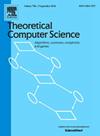Self-similarity of communities of the ABCD model
IF 0.9
4区 计算机科学
Q3 COMPUTER SCIENCE, THEORY & METHODS
引用次数: 0
Abstract
The Artificial Benchmark for Community Detection (ABCD) graph is a random graph model with community structure and power-law distribution for both degrees and community sizes. The model generates graphs similar to the well-known LFR model but it is faster and can be investigated analytically. In this paper, we show that the ABCD model exhibits some interesting self-similar behaviour, namely, the degree distribution of ground-truth communities is asymptotically the same as the degree distribution of the whole graph (appropriately normalized based on their sizes). As a result, we can not only estimate the number of edges induced by each community but also the number of self-loops and multi-edges generated during the process. Understanding these quantities is important as (a) rewiring self-loops and multi-edges to keep the graph simple is an expensive part of the algorithm, and (b) every rewiring causes the underlying configuration models to deviate slightly from uniform simple graphs on their corresponding degree sequences.
求助全文
约1分钟内获得全文
求助全文
来源期刊

Theoretical Computer Science
工程技术-计算机:理论方法
CiteScore
2.60
自引率
18.20%
发文量
471
审稿时长
12.6 months
期刊介绍:
Theoretical Computer Science is mathematical and abstract in spirit, but it derives its motivation from practical and everyday computation. Its aim is to understand the nature of computation and, as a consequence of this understanding, provide more efficient methodologies. All papers introducing or studying mathematical, logic and formal concepts and methods are welcome, provided that their motivation is clearly drawn from the field of computing.
 求助内容:
求助内容: 应助结果提醒方式:
应助结果提醒方式:


